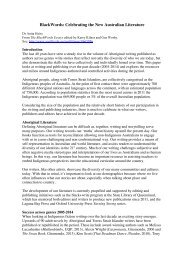7209743364812265548-Aboriginal-Literature-for-Children
7209743364812265548-Aboriginal-Literature-for-Children
7209743364812265548-Aboriginal-Literature-for-Children
You also want an ePaper? Increase the reach of your titles
YUMPU automatically turns print PDFs into web optimized ePapers that Google loves.
policy of “Protection” in South Australia (2). Down the Hole is a children’s book that takesvery complex aspects of history and politics and translates them into terms simple enough <strong>for</strong>children and adults to understand, and to try to relate to and engage with.The story tells of Edna, originally from Tarcoola, and Eileen of Ingomar Station, and theirchildhood experiences of avoiding the dreaded “State People” who visited Coober Pedywhere the girls grew up. We read of children hiding in bushes and the extraordinary lengthsto which parents went to ensure their children weren’t taken, such as putting them down holesin the ground and then sending food down by rope:My old people used to chuck us down pitingka – chuck us down the holes … We usedto sit down real quiet too … And the poor Old People used to look around everywherebe<strong>for</strong>e they can send a feed down, you know. (12-14)The memory recall in this story is not laden with terror or even bitterness, which makes itlikely that young readers will not be frightened by the story, but instead concerned about whyyoung <strong>Aboriginal</strong> children had a life so different to their own today. Such desperate measuresby parents, behaviour that today would never be necessary or acceptable in a civilisedsociety, will have young readers asking, “Why did the kids have to hide? Why did theGovernment want to take the <strong>Aboriginal</strong> kids away?” A short essay <strong>for</strong> older readers andeducators, titled “Why Were They Hiding?” is included at the back of the book to helpprepare teachers and others <strong>for</strong> the anticipated questions from children.This story will transport readers back in time in Australian history and help youngAustralians to understand the reality of <strong>Aboriginal</strong> life under the Protection Acts. This storywill not instill fear because it is told with a sense of simple reality: that this is how it was <strong>for</strong>the families and they did what needed to be done to protect children from removal bygovernment authorities. Rather than a tool to teach young readers about hideous aspects ofAustralian history, such as injustices committed against <strong>Aboriginal</strong> people, it would best beconsidered as a book that outlines major differences between the life experiences of mostyoung Australians today and young <strong>Aboriginal</strong> children of the past.Fittingly, there is also a brief piece titled “About Daisy Bates”, which explains the negativereferences to Bates throughout the book:Daisy Bates was famous <strong>for</strong> her writing and charitable work but not everyone likedher … In her popular book, The Passing of the Aborigines, she made it clear that shethought <strong>Aboriginal</strong> people were dying out, and she was also intolerant of ‘half-caste’or mixed descent children … But … she used her own money as well as donations toprovide food, clothing and basic medical care <strong>for</strong> her Anangu neighbours. (48)The book design by Louise Wellington and Brenda Thornley warrants particular mention.Text in language (also written phonetically) and English sitting side-by-side in the story, withexplanations down the left-hand side of the page, assists in the reclamation of language,adding another dimension to an already culturally and socially significant product.This work also has personal meaning <strong>for</strong> the illustrator Kunyi June-Anne McInerney, herselftaken from her family at a young age, when she was known as Kunyi, and placed in theOodnadatta children’s Mission, where she was renamed Anne. The illustrations are life-likeand at times sombre but they are not depressing, thereby ensuring that young readers will not




